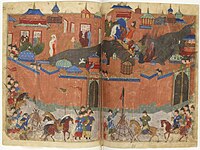This article needs additional citations for verification. (March 2016) |
| Destruction under the Mongol Empire | |
|---|---|
| Part of the Mongol conquests | |
 Depiction of the siege of Baghdad in February 1258, when the Mongol army killed up to 2,000,000 people throughout the city and devastated the Abbasid Caliphate within Mesopotamia | |
| Location | Eurasia |
| Date | 1207 – 1405 |
Attack type | Massacre, famine, genocide, androcide[1][2][3][4] |
| Deaths | 20 to 60 million[5][6][7] |
| Perpetrator | Mongol Empire |
The Mongol conquests resulted in widespread and well-documented death and destruction throughout Eurasia, as the Mongol army invaded hundreds of cities and killed millions of people. One estimate is that approximately 10% of the contemporary global population, amounting to some 37.75–60 million people, was killed either during or immediately after the Mongols' military campaigns.[8] As such, the Mongol Empire, which remains the largest contiguous polity to ever have existed, is regarded as having perpetrated some of the deadliest acts of mass killing in human history.
More recently, the Mongol Empire's conquests have been classified as genocidal.[9] British historian John Joseph Saunders, for example, described Mongol troops as "the most notorious practitioners of genocide".[10]
- ^ Jones, Adam (2006). Genocide: A Comprehensive Introduction. Routledge/Taylor & Francis Publishers. ISBN 978-0-415-35385-4. p.3
- ^ The Encyclopedia of Genocide, ABC-CLIO, 1999, p. 48, article "Afghanistan, Genocide of"
- ^ Man, John (2004), Genghis Khan: Life, Death, and Resurrection, New York, NY: St. Martin's Press, ISBN 9780312366247 p.116-117
- ^ The Secret History of the Mongols: Translated, Annotated, and with an Introduction by Urgunge Onon (2001). pp. 53-54, 57, 61, 111-135, 205
- ^ Ho, Ping-Ti (1970). "An estimate of the total population of Sung-Chin China". Histoire et institutions, 1. pp. 33–54. doi:10.1515/9783111542737-007. ISBN 978-3-11-154273-7. OCLC 8159945824.
- ^ McEvedy, Colin; Jones, Richard M. (1978). Atlas of World Population History. New York, NY: Puffin. p. 172. ISBN 9780140510768.
- ^ Graziella Caselli, Gillaume Wunsch, Jacques Vallin (2005). "Demography: Analysis and Synthesis, Four Volume Set: A Treatise in Population". Academic Press. p.34. ISBN 0-12-765660-X
- ^ "Twentieth Century Atlas - Historical Body Count". necrometrics.com. Retrieved 2020-10-21.
- ^ Wyatt, Don J. (2021). "Slavery and the Mongol Empire". In Allen, Richard B. (ed.). Slavery and Bonded Labor in Asia, 1250–1900. BRILL. p. 111. ISBN 9789004469655.
- ^ Buchstein, Fred (2001). "The History of the Mongol Conquests". The Journal of Military History. 65 (4). Lexington: 1081–1082. doi:10.2307/2677636. JSTOR 2677636. S2CID 162821241.